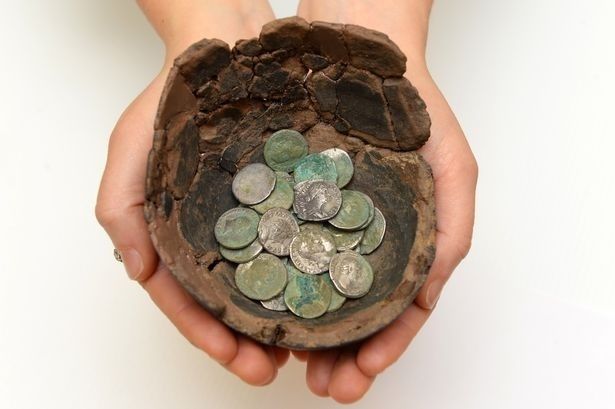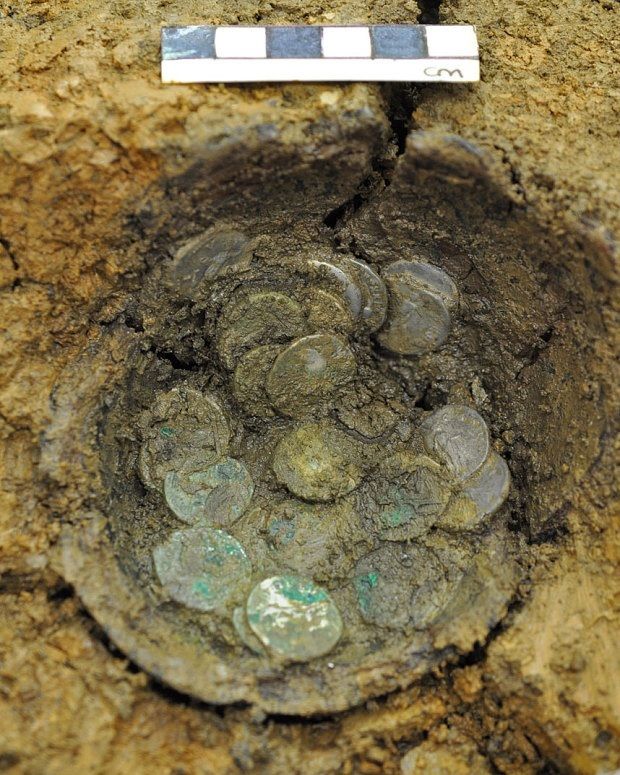|
|
Post by UKarchaeology on Nov 27, 2015 13:33:14 GMT
The discovery of the 2,000-year-old silver coins in the village of Wick, Wales, comes as archaeologists found a Roman fort on Anglesey  Coins issued by Mark Antony have been discovered in a Welsh fieldA haul of valuable coins issued by Roman general Mark Antony have been discovered in a Welsh field - more than 2,000 years after they were buried. Coins issued by Mark Antony have been discovered in a Welsh fieldA haul of valuable coins issued by Roman general Mark Antony have been discovered in a Welsh field - more than 2,000 years after they were buried.It comes as archaeologists claimed to have found a small Roman fort on Anglesey, North Wales, in what has been described as a "ground-breaking" discovery. The coins - unearthed by two friends out walking - have been hailed by historians as "a significant find". Dr Richard Annear, 65, and John Player, 43, found the silver coins dating back to 31 BC buried in a field near the small village of Wick, South Wales. Consultant Psychiatrist Dr Annear reported the find to curators who were able to lift a small pot containing the coins out of the ground. A numismatist described the three Roman denarii coins as "worth tens of thousands of pounds". Full story: www.mirror.co.uk/news/uk-news/roman-coins-issued-mark-antony-6909948 |
|
|
|
Post by UKarchaeology on Nov 27, 2015 15:36:20 GMT
Another article on the matter; Hoard of Roman silver coins found buried in Welsh field A hoard of silver coins issued by Roman general Mark Antony, discovered in a Welsh field more than 2,000 years after they were buried, have been declared treasure. The coins, which experts believe could be worth tens of thousands of pounds, were found by two friends out walking with metal detectors near the village of Wick, Vale of Glamorgan. One of the pair, consultant psychiatrist Dr Richard Annear, 65, reported the find to curators who were able to lift a small pot containing the coins out of the ground, according to the South Wales Evening Post.  A hoard of coins issued by Roman general Mark Antony have been discovered in a Welsh field Photo: National Museum Wales/Wales News A hoard of coins issued by Roman general Mark Antony have been discovered in a Welsh field Photo: National Museum Wales/Wales News The haul of 91 coins is believed to have been issued by Roman rulers spanning 200 years, with the earliest dating back to 31BC, when Mark Antony, a key ally of emperor Julius Caesar, played critical role in the formation of the Roman Empire. The newest coins bear the image of Marcus Aurelius, the Stoic philosopher and Roman emperor who ruled between 161AD to 180AD. Edward Besly, numismatist at National Museum Wales, said: “Each coin represents about a day’s pay at the time, so the hoard represents a significant sum of money. “The hoard’s find spot is only a mile as the crow flies from that of another second century silver hoard found at Monknash in 2000, which compromised 103 denarii, buried a little earlier, around 150AD. Full story: www.telegraph.co.uk/news/earth/environment/archaeology/12020410/Hoard-of-Roman-silver-coins-found-buried-in-Welsh-field.html |
|
|
|
Post by ikuvoguhi on Jun 6, 2019 15:30:44 GMT
|
|
|
|
Post by anoxejuwesag on Jun 6, 2019 17:09:28 GMT
|
|